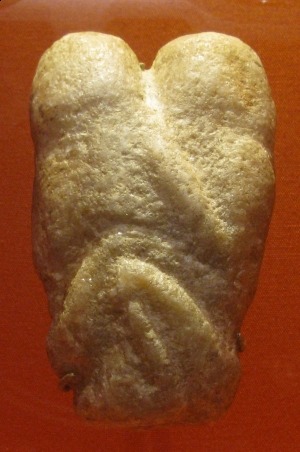Friday 2 January 2015

Photo, above: The Ain Sakhri lovers. British Museum. Discovered in Ain Sakhri caves, Wadi Khareitoun near Bethlehem; 9000 BCE. See Hour 2, Block A, Michael Balter, Science magazine.
What Happened in the Natufian? by EDWARD PEGLER on 11 JUNE, 2010 (text by courtesy of and with thanks to armchairprehistory.com) The Natufian culture holds a special place in the hearts of archaeologists. It appeared in the Levant (modern Palestine, Israel, Syria and Jordan) about 12,500 BC and lasted until 9500 BC* (the end of the Epipalaeolithic, sometimes rather confusingly called the Mesolithic). With this culture the world changed forever. Before the Natufian, roaming hunter-gatherers, known as the Kebaran culture, trudged the Mediterranean coast as their ancestors had for thousands upon thousands of years. What the Natufians appear to have done, and were possibly the first to have done, is to say “Enough! I’m stopping here thank you,” and build villages.
In size, these villages are very small by modern standards, no more than forty metres across and with populations of fewer than a couple of hundred people. But they are weird considering there’s almost nothing like them before. The houses are crude, more like shacks, but they do show a surprising degree of care in their organisation and maintenance. Also, whilst there’s no pottery there are stone bowls and grinding stones. Perhaps most importantly these seem to have been all-year-round settlements. The teeth of hunted animals such as gazelle show that both summer and winter kills were brought back to the villages. Also, there’s plenty of evidence for house mice and rats in numbers appropriate to a village occupied all year.
Connections with the Neolithic What intrigues archaeologists most about the Natufian is that, just under three thousand years later, the Neolithic, with the first evidence in the world of agriculture, started in pretty much the same place. It’s difficult not to see the two events as connected, with one leading to the other. The question that archaeologists have asked since the discovery of these earliest villages is “Why then? Why there?” A number of factors have been suggested. [more]
JOHN BATCHELOR SHOW
Hour One
Friday 2 January 2015 / Hour 1, Block A: Harry Siegel, New York Daily News, in re:
Friday 2 January 2015 / Hour 1, Block B: Jennifer Kingston, NYT, in re:
Friday 2 January 2015 / Hour 1, Block C: Robert Kaplan, Stratfor, in re: Asia's Cauldron, the end of stability in the South China Sea; the latter compared to the US in the Caribbean a century ago, where the US gained strategic control of the Western Hemisphere. US didn't much kick European powers out; rather, as they left, prevented their return. First, the Americans settled the entire continent from Atlantic to Pacific; then extended control to the Caribbean. China sees the South China Sea as a blue-water extension of their land mass. Via he Strait of Malacca, China gains control from almost Vladivostok to near India; it thus becomes a budding world power. Yalong Bay near Hainan: underground sub base. Going from a unipolar US-controlled Western Pacific to a multipolar space: anti-access area denial (subs, ballistic missiles, coast guard, etc,. so US navy cannot enter without extreme care. . . . (1 of 2)
Friday 2 January 2015 / Hour 1, Block D: Robert Kaplan, Stratfor, in re: Asia's Cauldron, the end of stability in the South China Sea; the latter compared to the US in the Caribbean a century ago, where the US gained strategic control of the Western Hemisphere. The Philippines. . . . (2 of 2)
Hour Two
Friday 2 January 2015 / Hour 2, Block A: Michael Balter, Science magazine, in re: human brains, species leaving Africa; excavations, long run-out to complex (modern) behavior in Africa stretching back as far as 100,000 years ago, before Homo sapiens. Symbolic behaviors; jewellery; earliest spear points from Katu Pond (University of Toronto scholars) going back perhaps 500,000 years. "Now You See It, Now You Don't" article by Israeli archaeologists. Farming communities of the Near East, Natufians – sophisticated hunter-gatherers. Eastern Jordan, Tobias Richter, et al., using shells from 2,000 miles away.
Friday 2 January 2015 / Hour 2, Block B: Ken Croswell, Science magazine, in re: stars and black holes
Friday 2 January 2015 / Hour 2, Block C: Gene Marks, in re:
Friday 2 January 2015 / Hour 2, Block D: Matt Richtel, NYT, in re:
Hour Three
Friday 2 January 2015 / Hour 3, Block A: Monica Crowley, Fox, & Washington Times Online opinion editor; in re: (1 of 2)
Friday 2 January 2015 / Hour 3, Block B: Monica Crowley, Fox, & Washington Times Online opinion editor; in re: (2 of 2)
Friday 2 January 2015 / Hour 3, Block C: Kara Brandeisky, Propublica, in re:
Friday 2 January 2015 / Hour 3, Block D: Brooks Barnes, NYT, in re:
Hour Four
Friday 2 January 2015 / Hour 4, Block A: John Lipscomb, author, _____, in re: (1 of 2)
Friday 2 January 2015 / Hour 4, Block B: John Lipscomb, author, _____, in re: (2 of 2)
Friday 2 January 2015 / Hour 4, Block C: Roman Saskiw, in re:
Friday 2 January 2015 / Hour 4, Block D: John Markoff, in re:
.. .. ..